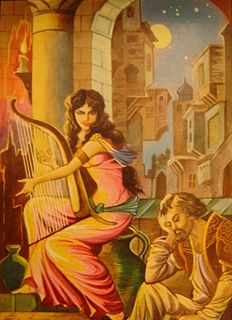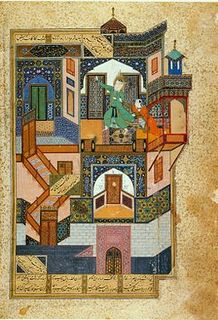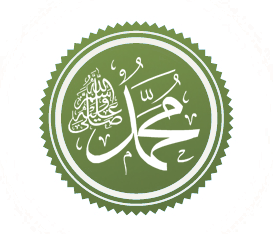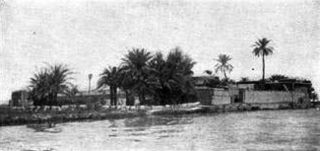
According to a hadith, there are at least 99 Attributes of Allah, known as the ʾasmāʾu llāhi l-ḥusnā. The names are also called 99 Attributes of Allah.

Khwāja Shams-ud-Dīn Muḥammad Ḥāfeẓ-e Shīrāzī, known by his pen name Hafez and as "Hafiz", was a Persian poet who "lauded the joys of love and wine but also targeted religious hypocrisy". His collected works are regarded as a pinnacle of Persian literature and are often found in the homes of people in the Persian speaking world, who learn his poems by heart and still use them as proverbs and sayings. His life and poems have been the subject of much analysis, commentary and interpretation, influencing post-14th century Persian writing more than any other author.

Yūsuf ibn Yaʿqūb ibn Is-ḥāq ibn Ibrāhīm is a Nabi mentioned in the Qurʾān, the scripture of Islam, and corresponds to Joseph, a person from the Tanakh, the Jewish religious scripture, and the Christian Bible, who was estimated to have lived in the 16th century BCE. It is one of the common names in the Middle East and among Muslim nations. Of all of Jacob's children, Joseph was the one given the gift of prophecy. Although the narratives of other prophets are mentioned in various Surahs, the complete narrative of Joseph is given only in one Surah, Yusuf, making it unique. It is said to be the most detailed narrative in the Qur'an and bears more details than the Biblical counterpart.

The Saffarid dynasty was a Muslim Persianate dynasty from Sistan that ruled over parts of eastern Iran, with its capital at Zaranj. Khorasan, Afghanistan and Sistan from 861 to 1003. The dynasty, of Persian origin, was founded by Ya'qub bin Laith as-Saffar, born in 840 in a small town called Karnin (Qarnin), which was located east of Zaranj and west of Bost, in what is now Afghanistan - a native of Sistan and a local ayyar, who worked as a coppersmith (ṣaffār) before becoming a warlord. He seized control of the Sistan region and began conquering most of Iran and Afghanistan, as well as parts of Pakistan, Tajikistan and Uzbekistan.

"Shahāb ad-Dīn" Yahya ibn Habash Suhrawardī (1154-1191) was a Persian philosopher and founder of the Iranian school of Illuminationism, an important school in Islamic philosophy that drew upon Zoroastrian and Platonic ideas. The "light" in his "Philosophy of Illumination" is a divine and metaphysical source of knowledge. He is referred to by the honorific title Shaikh al-ʿIshraq "Master of Illumination" and Shaikh al-Maqtul "the Murdered Master", in reference to his execution for heresy. Mulla Sadra, the Persian sage of the Safavid era described Suhrawardi as the "Reviver of the Traces of the Pahlavi (Iranian) Sages", and Suhrawardi, in his magnum opus "The Philosophy of Illumination", thought of himself as a reviver or resuscitator of the ancient tradition of Persian wisdom.
Shaykh Shahab al-Din Abu Hafs Umar Suhrawardi (c.1145-1234) was a Persian Sufi and nephew of Abu al-Najib Suhrawardi. He expanded the Sufi order of Suhrawardiyya that had been created by his uncle Abu al-Najib Suhrawardi, and is the person responsible for officially formalizing the order. Suhrawardi is the author of the Awarif ul-Maarif, which is recognized as a masterpiece work in Tasawwuf.

Islam considers the Quran to be a holy book, the word of Allah, and a miracle. The text itself is believed to be a miracle on the grounds that the Arabic text would not conform to the standard poetry and prose categories commonly expressed by other forms of written and spoken languages and therefore is attributed to supernatural, esp. divine, agency; esp. an act showing control over nature and used as evidence that the agent is either divine or divinely favoured.
Maktab or Maktabeh or Maktabkhaneh, also called a Kuttab “school” is an Arabic word meaning elementary schools. Though it was primarily used for teaching children in reading, writing, grammar and Islamic studies such as Qira'at, other practical and theoretical subjects were also often taught. Until the 20th century, maktabs were the prevalent means of mass education in much of the Islamic world.

Sirat-un-Nabi is one of the most famous and authentic Sirah Rasul Allah (biographies) of the Islamic prophet Muhammad, written in Urdu by Shibli Nomani and his student, Sulaiman Nadvi in 7 volumes.

Uzair is a figure mentioned in the Quran, in the verse 9:30, which states that he was revered by the Jews as "the prophet of God". Uzair is most often identified with the biblical Ezra. Modern historians have described the reference as "enigmatic", since such views have not been found in Jewish sources. Islamic scholars have interpreted the Qur'anic reference in different ways, with some explaining that it alluded to a specific group of Jews.

The True Furqan, al-Furqan al-Haqq is a book written in Arabic mirroring the Qur'an but incorporating elements of traditional Christian teaching.
Abolsamad Khorramshahi is an Iranian lawyer.
At-Tibyan Fi Tafsir al-Quran is an exegesis of the Quran in ten volumes written by Shaykh Tusi. Shaykh Tabarsi, the author of Majma' al-Bayan, admitted using this book in writing his commentary. A copy is available at the Malek Library, Tehran. This exegesis has been published along with its summary as Mukhtasar-ut-Tibyan. The author uses hadith as a major component in writing his commentary and preserves the traditions of several of Twelver Shi'i imams.
Tasneem Tafsir is an exegesis of the Quran by contemporary Shia scholar Abdollah Javadi Amoli.
Rawz al-jinan wa ruh al-jinan also known as Tafsīr Abū al- Futūḥ is an exegesis on the Quran written by Abu l-Futuh al-Razi in the 12th century. The book, consisting of twenty volumes, is the earliest surviving Persian tafsīr with an Imāmī Shīʿī emphasis. It delves into mystical themes regularly.

Khorramshahi is a village in Dalfard Rural District, Sarduiyeh District, Jiroft County, Kerman Province, Iran. At the 2006 census, its population was 61, in 15 families.

Tang-e Baha ol Dini is a village in Howmeh Rural District, in the Central District of Larestan County, Fars Province, Iran. At the 2006 census, its population was 28, in 9 families.

The Birmingham Quran manuscript is a parchment on which two leaves of an early Quranic manuscript are written. In 2015 the manuscript, which is held by the University of Birmingham, was radiocarbon dated to between 568 and 645 AD. It is part of the Mingana Collection of Middle Eastern manuscripts, held by the university's Cadbury Research Library.













